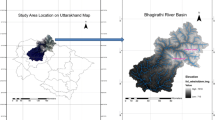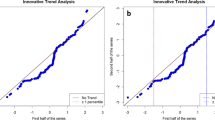Abstract
In the present study, a seasonal and non-seasonal prediction of the Standardized Precipitation Index (SPI) time series is addressed by means of linear stochastic models. The methodology presented here is to develop adequate linear stochastic models known as autoregressive integrated moving average (ARIMA) and multiplicative seasonal autoregressive integrated moving average (SARIMA) to predict drought in the Büyük Menderes river basin using SPI as drought index. Temporal characteristics of droughts based on SPI as an indicator of drought severity indicate that the basin is affected by severe and more or less prolonged periods of drought from 1975 to 2006. Therefore, drought prediction plays an important role for water resources management. ARIMA modeling approach involves the following three steps: model identification, parameter estimation, diagnostic checking. In model identification step, considering the autocorrelation function (ACF) and partial autocorrelation function (PACF) results of the SPI series, different ARIMA models are identified. The model gives the minimum Akaike Information Criterion (AIC) and Schwarz Bayesian Criterion (SBC) is selected as the best fit model. Parameter estimation step indicates that the estimated model parameters are significantly different from zero. Diagnostic check step is applied to the residuals of the selected ARIMA models and the results indicated that the residuals are independent, normally distributed and homoscedastic. For the model validation purposes, the predicted results using the best ARIMA models are compared to the observed data. The predicted data show reasonably good agreement with the actual data. The ARIMA models developed to predict drought found to give acceptable results up to 2 months ahead. The stochastic models developed for the Büyük Menderes river basin can be employed to predict droughts up to 2 months of lead time with reasonably accuracy.








Similar content being viewed by others
References
Abramowitz M, Stegun A (1965) Handbook of mathematical formulas, graphs, and mathematical tables. Dover Publications Inc., New York
Box GEP, Jenkins GM (1976) Time series analysis forecasting and control. Holden-Day, San Francisco
Box GEP, Jenkins GM, Reinsel GC (1994) Time series analysis, forecasting and control. Prentice Hall, Englewood Cliffs, NJ, USA
Bozdogan H (2000) Akaike’s information criterion and recent developments in information complexity. J Math Psychol 44:62–91
Cancelliere A, Rossi G, Ancarani A (1996) Use of Palmer Index as drought indicator in Mediterranean regions. In: Proc IAHR congress ‘‘From flood to drought’’, Sun City, South Africa, 5–7 August 1996, p S4.12-1-25
Cancelliere A, Di Mauro G, Bonaccorso B, Rossi G (2007) Drought forecasting using the Standardized Precipitation Index. Water Resour Manage 21:801–819
Dracup JA, Lee KS, Paulson EG Jr (1980) On the definition of droughts. Water Resour Res 16:297–302
Edwards DC, McKee TB (1997) Characteristics of 20th century drought in the United States at multiple time scales. Climatology Rep 97-2. Colorado State University, Dept. of Atmospheric Science, Fort Collins, Colorado, 155 pp
El-Din AG, Smith DW (2002) A combined transfer-function noise model to predict dynamic behavior of a full-scale primary sedimentation tank. Water Res 36:3747–3764
Eminoğlu E (2007) Büyük Menderes basin irrigation planning. In: Proceedings of the international congress on river basin management, Antalya, Turkey, State Hydraulic Works, Ankara, 22–24 March 2007, pp 890–899
Fernandez C, Vega JA, Fonturbel T, Jimenez E (2008) Streamflow drought time series forecasting: a case study in a small watershed in North West Spain. Stoch Environ Res Risk Assess 23:1063–1070
Guttman NB (1998) Comparing the Palmer Drought Index and the Standardized Precipitation Index. J Am Water Resour Assoc 34(1):113–121
Haan CT (1977) Statistical methods in hydrology. Iowa State Press, Iowa
Hayes MJ, Svoboda MD, Wilhite DA, Vanyarkho OV (1999) Monitoring the 1996 drought using the Standardized Precipitation Index. Bull Am Meteorol Soc 80(2):429–438
Heim RR (2000) Drought indices: a review. In: Wilhite DA (ed) Drought: a global assessment. Routledge, London
Labedzki L (2007) Estimation of local drought frequency in central Poland using the Standardized Precipitation Index SPI. Irrigation Drainage 56:67–77
Livada I, Assimakopoulos VD (2007) Spatial and temporal analysis of drought in Greece using the Standardized Precipitation Index (SPI). Theor Appl Climatol 89:143–153
Lloyd-Hughes B, Saunders MA (2002) A drought climatology for Europe. Int J Climatol 22:1571–1592
Lohani VK, Loganathan GV, Mostaghimi S (1998) Long term analysis and short-term forecasting of dry spells by Palmer drought severity index. Nord Hydrol 29(1):21–40
Loukas A, Vasiliades L (2004) Probabilistic analysis of drought spatiotemporal characteristics in Thessaly region, Greece. Nat Hazards Earth Syst Sci 4:719–731
Makridakis S, Wheelwright SC, Hyndman R (2003) Forecasting methods and applications. Wiley (ASIA) Pvt. Ltd., Singapore
Marquardt DW (1963) An algorithm for least squares estimation of non-linear parameters. Soc Indust Appl Math 11:431–441
McKee TB, Doesken NJ, Kliest J (1993) The relationship of drought frequency and duration to time scales. In: Proceedings of the eighth conference on applies climatology, Anaheim, CA, 17–22 January 1993. American Meteorological Society, Boston, MA, USA, pp 179–184
Mishra AK, Desai VR (2005) Drought forecasting using stochastic models. Stoch Environ Res Risk Assess 19:326–339
Mishra AK, Desai VR (2006) Drought forecasting using feed-forward recursive neural network. Ecol Model 198:127–138
Mishra AK, Singh VP, Desai VR (2009) Drought characterization: a probabilistic approach. Stoch Envron Res Risk Assess 23:41–55
Modarres R (2007) Streamflow drought time series forecasting. Stoch Environ Res Risk Assess 21:223–233
Panu US, Sharma TC (2002) Challenges in drought research: some perspectives and future directions. Hydrol Sci 47(S):19–30
Patel NR, Chopra P, Dadhwal VK (2007) Analyzing spatial patterns of meteorological drought using Standardized Precipitation Index. Meteorol Appl 14:329–336
Rao AR, Padmanabhan G (1984) Analysis and modelling of palmer’s drought index series. J Hydrol 68:211–229
Rossi G (2003) Requisites for a drought watch system. In: Rossi G et al (eds) tools for drought mitigation in Mediterranean regions. Kluwer Academic Publishing, Dordrecht, pp 147–157
Sönmez FK, Kömüşcü AU, Erkan A, Turgu E (2005) An analysis of spatial and temporal dimension of drought vulnerability in Turkey using the Standardized Precipitation Index. Nat Hazards 35:243–264
Thom HCS (1958) A note on the gamma distribution. Monthly Weather Rev 86:117–122
Wilhite DA (2000) Drought as a natural hazard: concept and definitions. In: Wilhite DA (ed) Drought: a global assessment. Routledge, pp 3–18
Wilhite DA, Glantz MH (1985) Understanding the drought phenomenon: the role of definitions. Water Int 10:111–120
Wilhite DA, Rosenberg NJ, Glantz MH (1986) Improving federal response to drought. J Clim Appl Meteorol 25:332–342
Wilhite DA, Hayes MJ, Svoboda MD (2000) Drought monitoring and assessment: status and trends in the United States. In: Vogt JV, Somma F (eds) Drought and drought mitigation in Europe. Academic Publishers, pp 149–160
Yurekli K, Kurunc A, Ozturk F (2005) Application of linear stochastic models to monthly flow data of Kelkit Stream. Ecol Model 183:67–75
Author information
Authors and Affiliations
Corresponding author
Rights and permissions
About this article
Cite this article
Durdu, Ö.F. Application of linear stochastic models for drought forecasting in the Büyük Menderes river basin, western Turkey. Stoch Environ Res Risk Assess 24, 1145–1162 (2010). https://doi.org/10.1007/s00477-010-0366-3
Published:
Issue Date:
DOI: https://doi.org/10.1007/s00477-010-0366-3




